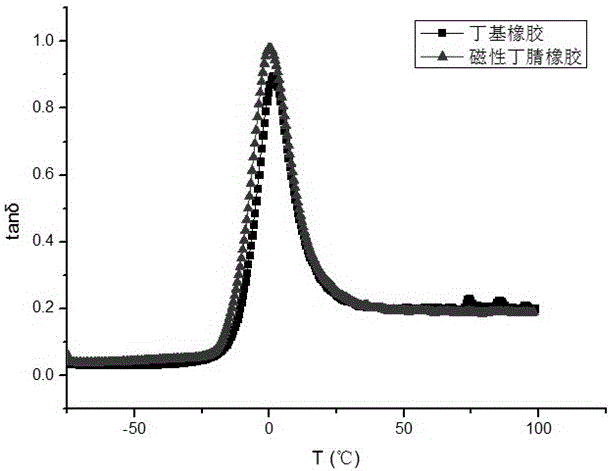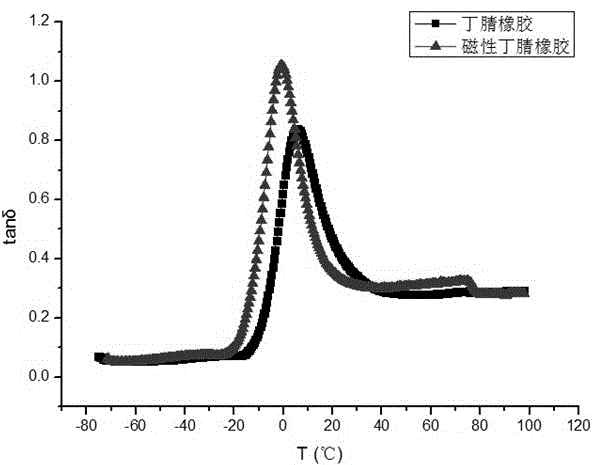Method for enhancing damping capacity of rubber by adding neodymium-iron-boron magnetic powder
A neodymium-iron-boron and magnetic powder technology, which is applied to magnetic materials, magnetic objects, electrical components, etc., can solve the problems that neodymium-iron-boron magnetic rubber is not suitable for application, and the coercivity of neodymium-iron-boron materials is low. Effectively damping the effect of increasing the temperature range and increasing energy conversion
- Summary
- Abstract
- Description
- Claims
- Application Information
AI Technical Summary
Problems solved by technology
Method used
Image
Examples
Embodiment 1
[0028] 1) Plasticize 100 parts by mass of butyl rubber on an open mill, then add 50 parts by mass of carbon black reinforcing agent, 20 parts by mass of isotropic fast-quenching NdFeB magnetic powder with a particle size of 100 microns, 2 mass parts Part sulfur, 5 parts by mass of zinc oxide, 1.5 parts by mass of stearic acid were mixed for 5 minutes to obtain a mixture;
[0029] 2) Put the mixture in the mold, apply a pressure of 5 Pa to the mold, and keep it at 120°C for 30 minutes for vulcanization to obtain vulcanized rubber;
[0030] 3) Place the vulcanized rubber under a 5T magnetic field and magnetize it for 1 second to obtain a high-damping NdFeB magnetic rubber.
[0031] The result is as figure 1 As shown, compared with ordinary butyl rubber, the maximum damping coefficient of NdFeB magnetic rubber with 20 mass parts of magnetic powder is increased from 0.85 to 0.98 at 50, an increase of 15%, and the damping performance is significantly improved.
Embodiment 2
[0033] 1) Plasticize 100 parts by mass of nitrile rubber on a calender, then add 35 parts by mass of carbon black reinforcing agent, 60 parts by mass of anisotropic fast-quenching NdFeB magnetic powder with a particle size of 1 micron, 1.5 parts by mass Sulfur, 5 parts by mass of zinc oxide, and 1 part by mass of stearic acid were kneaded for 5 minutes to obtain a mixture;
[0034] 2) Put the mixture in the mold, apply a pressure of 15Pa to the mold, and keep it at 150°C for 10 minutes for vulcanization to obtain vulcanized rubber;
[0035] 3) Place the vulcanized rubber under a 4T magnetic field for 5 seconds to obtain a high-damping NdFeB magnetic rubber.
[0036] Compared with ordinary butyl rubber, the maximum damping coefficient of NdFeB magnetic rubber with 60 mass parts of magnetic powder increased from 0.84 to 1.05 at 50, an increase of 25%, and the damping performance was significantly improved.
Embodiment 3
[0038] 1) Plasticize 100 parts by mass of silicone rubber on a mixer, then add 50 parts by mass of white carbon black reinforcing agent, 120 parts by mass of isotropic injection-molded NdFeB magnetic powder with a particle size of 70 microns, and 0.8 parts by mass of sulfur , mixed for 15 minutes to obtain a mixture;
[0039] 2) Put the mixture in the mold, apply a pressure of 20Pa to the mold, and keep it at 170°C for 20 minutes for vulcanization to obtain vulcanized rubber;
[0040] 3) Place the vulcanized rubber under a 1.5T magnetic field for 10 seconds to obtain a high-damping NdFeB magnetic rubber.
[0041] Compared with ordinary silicone rubber, the maximum damping coefficient of NdFeB magnetic rubber with 120 mass parts of magnetic powder increased from 0.34 to 0.40 at 50, an increase of 18%, and the damping performance was significantly improved.
PUM
| Property | Measurement | Unit |
|---|---|---|
| particle diameter | aaaaa | aaaaa |
Abstract
Description
Claims
Application Information
 Login to View More
Login to View More - R&D
- Intellectual Property
- Life Sciences
- Materials
- Tech Scout
- Unparalleled Data Quality
- Higher Quality Content
- 60% Fewer Hallucinations
Browse by: Latest US Patents, China's latest patents, Technical Efficacy Thesaurus, Application Domain, Technology Topic, Popular Technical Reports.
© 2025 PatSnap. All rights reserved.Legal|Privacy policy|Modern Slavery Act Transparency Statement|Sitemap|About US| Contact US: help@patsnap.com



